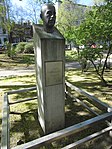Bust of Carl Legien
1959 sculpturesBronze sculptures in GermanyBusts in GermanyFriedrichshain-KreuzbergGermany sculpture stubs ... and 4 more
Monuments and memorials in BerlinOutdoor sculptures in BerlinSculptures of men in GermanyStone sculptures in Germany

A 1959 bust of Carl Legien by Karl Trumpf is installed along Legiendamm in Kreuzberg, Berlin, Germany.
Excerpt from the Wikipedia article Bust of Carl Legien (License: CC BY-SA 3.0, Authors, Images).Bust of Carl Legien
Legiendamm, Berlin Kreuzberg
Geographical coordinates (GPS) Address External links Nearby Places Show on map
Geographical coordinates (GPS)
| Latitude | Longitude |
|---|---|
| N 52.50352 ° | E 13.41654 ° |
Address
Carl Legien
Legiendamm
10999 Berlin, Kreuzberg
Germany
Open on Google Maps










